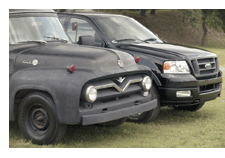A bold new look and some subtle changes probably best describe the 2004-and-up Ford F150. To the technician, it is the subtle changes that he or she needs to be aware of.
Starting with the 2004 model year, Ford launched a new body style for the F150. The new body style truck is a new vehicle inside and out. However, not all of the 2004 F150s that you see will be the new body style. The 2004 F150 was also made available in the older body style pick up that came on the scene in 1996. Just like when they made the body style change in 1996, Ford didn’t just stop one model and start an new one. Instead, they produced both body styles in the same year. Just like you could get a 1996 in two different bodies, the 2004 does the same thing. In 2004, the older body style F150 is called a “Heritage” edition. The newer body style is simply referred to as an 2004 “new” model. You do need to be aware of this for correct ordering of parts, and parts look up.
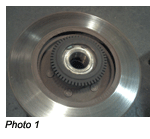 Brakes
Brakes
One significant design change is to the front rotors. On the 4×2 “NEW” F150, the front wheel bearings are now sealed bearings that are pressed into the rotors and secured with a snap ring. (See Photo 1.)
This design calls for a special adapter for your bench-style brake lathe. If you use a bench style brake lathe, you also need to be aware that the retaining nut for the rotor is not intended for reuse. For this reason, it may be wise for your shop to stock two retaining nuts for 2004-and-up F150 2WD. (See Photo 2.)
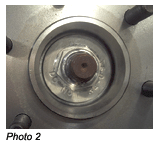 If your shop uses an on-car lathe, you will need a new adapter as well for the new lug nut pattern on these vehicles. The 4×4 is a hub-less design rotor and requires no special bench lathe adapter beyond what is needed for any hub-less rotor.
If your shop uses an on-car lathe, you will need a new adapter as well for the new lug nut pattern on these vehicles. The 4×4 is a hub-less design rotor and requires no special bench lathe adapter beyond what is needed for any hub-less rotor.
On these trucks, the rotors are proving to wear as fast as many European cars do. Usually, these rotors only make it through about one resurfacing before needing to be replaced. The replacement rotors from the dealer come with a new bearing already loaded into them.
Lifting the Truck and the Hood
On the “new” model F-Series trucks, be sure to fold the side view mirrors in when raising these trucks on a two-post lift. The mirrors are large enough that they have been crushed by the plate or cap found a the top of the lift posts.
This one last issue might seem excessively simple to talk about, but can be very embarrassing in front of the customer if you are not prepared. The secondary hood release handle has moved on the 2008 Super Duty. It is now below the inside lower corner of the right headlight.
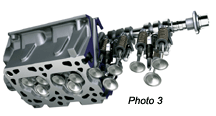 Spark Plugs
Spark Plugs
Watch out when changing the spark plugs on the 5.4L three-valve engine found in 2004-and-up F150 and 2005-and-up Expedition and Navigator (See Photo 3.) First of all, you’d better check your cost on the spark plugs. They are nothing like the conventional design of spark plug in the years past, and the price is nothing near traditional either.
Secondly, they use a 9/16th spark plug socket. So, if you don’t have the right plug socket, it’s time to buy another socket before one rolls into your shop. Lastly, you don’t just grab these puppies and start turning on them. These things have the electrodes located about an inch and a half away from the threads, mounted on the end of a ground electrode shell. The shell rusts from moister. Upon removal, the shell can snap off in the head from a combination of the rust and built up carbon binding the shell in the head, and from the shell being weakened from rusting.
To aid removal, first turn the spark plug enough to lift the spark plug seat from the head, about 1/8th of a turn to 1/4 of a turn. Then, add a tiny amount of penetrating oil to each spark plug. Let the oil soak for about 10 minutes, then remove the spark plugs. You may have to work the plug in and out as you remove it. Some “screeching” sound is normal and about 33 lb-ft of torque my be required to work the plug through it’s threading. Do not do these on an extra hot engine, or stone cold either. The engine should be warm to the touch. If a spark plug breaks off, there is a special tool and procedures for removal. At this point, I’m going to just point you to Ford TSB article 06-15-02 where it explains the special tool and procedure in the event a plug snaps.
On the brighter side, these trucks are not as hard to access the plugs as with the Ford trucks in the past. The driver’s side is fairly open, and the passenger side opens up well if you remove the PCM and bracket. On 2007-and-up, you’ll find wide open spaces under the hood for easy access. Also, when replacing the spark plugs in these trucks, be sure they are the updated spark plug.
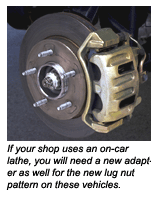 The first design of spark plug caused spark knocking and engine damage. Short blocks and long blocks were replaced under warranty over this. Consult TSB article 06-03-03, or the older version 05-25-05, and make sure you are installing the PZT-1F-F4 spark plugs. If you are using an aftermarket plug, you will need to verify that the aftermarket plug you are installing is made to the same specs as the PZT-1F and NOT the PZT-2F. If you install the PZT-2F or an aftermarket plug designed to match that plug, you may end up buying someone an engine.
The first design of spark plug caused spark knocking and engine damage. Short blocks and long blocks were replaced under warranty over this. Consult TSB article 06-03-03, or the older version 05-25-05, and make sure you are installing the PZT-1F-F4 spark plugs. If you are using an aftermarket plug, you will need to verify that the aftermarket plug you are installing is made to the same specs as the PZT-1F and NOT the PZT-2F. If you install the PZT-2F or an aftermarket plug designed to match that plug, you may end up buying someone an engine.
Oil Changes
Watch out when you change the oil on one of these three-valve engines found on 2004-and-up F Series. The cam sprockets on these are variable timing sprockets called phasers. The cam phasers have six metal tabs that stick out from the sides of the phasers. These metal tabs excite the cam sensors to tell the PCM the exact position of the cam shaft. The right hand phaser is located directly under the oil filler neck, and can be viewed by looking down the oil fill neck. Occasionally, a careless oil change tech will leave the oil gun in the filler neck and start the engine up. The tabs are then bent and broken from the phaser. This causes anything from just a check engine light with a cam sensor code, to a severe loss of power from the PCM over advancing the camshaft.
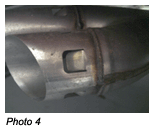 Shakes and Rattles
Shakes and Rattles
When dealing with rattles, vibrations and other ride issues on these trucks, be certain to check TSBs. These trucks have numerous rattle and vibration issues that require very specific repairs to address very specific ride complaints. TSB 05-21-19 explains an updated rotor design and even an updated rack and pinion design, for very early build dates to address a brake vibration. TSB 06-19-16 speaks of shimming the center drive shaft support bearing to stop a momentary shudder on acceleration. TSB 06-12-02 has you install some weights on the frame at the rear of the truck after checking the tires on a balancer that has road force measurement. For a momentary single “bump” feeling when stopping and accelerating, see TSB 05-26-11 about greasing the drive shaft slip yoke. Even the ash tray has a rattle concern addressed in TSB 16-13-19.
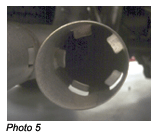 Diesel Exhaust Service
Diesel Exhaust Service
Another issue that a technician should be aware of, pertains to the odd looking exhaust tips found on the 2008-and-up F-Super Duty diesels. These tips should not be removed or covered with dress sleeves that will seal off the ports on the sides. (See Photo 4.)
The new generation of diesel engines from all makes, will have some odd looking exhaust tips on them. The tips are designed to draw cool air into the tip, by use of venturi action, to cool the exiting gasses during filter regeneration. (See Photo 5.)
During filter regeneration mode, the exhaust temperatures are more intense than normal. Without the special tips, the exiting gasses become hazardous to the paint on the truck’s body, dry grass that might catch fire, or someone’s legs who happen to be standing too close to the tail pipe.
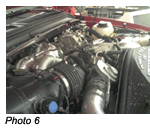 What is filter regeneration mode? That’s another new thing that the undercar tech needs to be aware of. Starting in 2008, the EPA has thrown the diesels a new curve ball. As part of the new regulations, they now have to be equipped with a particulate filter after the catalyst. The job of the filter is to trap soot. Periodically, the PCM performs a regeneration on the filter. During regeneration mode, raw fuel is injected into the filter to literally burn the soot out of the filter. The soot is reduced to ash and drops to the bottom of the filter. The ash never leaves the particulate filter assembly. Eventually, the filters will require replacement. In time, this will open a new market as these filters start needing replacement.
What is filter regeneration mode? That’s another new thing that the undercar tech needs to be aware of. Starting in 2008, the EPA has thrown the diesels a new curve ball. As part of the new regulations, they now have to be equipped with a particulate filter after the catalyst. The job of the filter is to trap soot. Periodically, the PCM performs a regeneration on the filter. During regeneration mode, raw fuel is injected into the filter to literally burn the soot out of the filter. The soot is reduced to ash and drops to the bottom of the filter. The ash never leaves the particulate filter assembly. Eventually, the filters will require replacement. In time, this will open a new market as these filters start needing replacement.
If your shop happens to do diesel work, be advised also that these trucks are extremely tight under the hood and cab removal is required to do most repairs beyond basic maintenance. (See Photo 6.)
